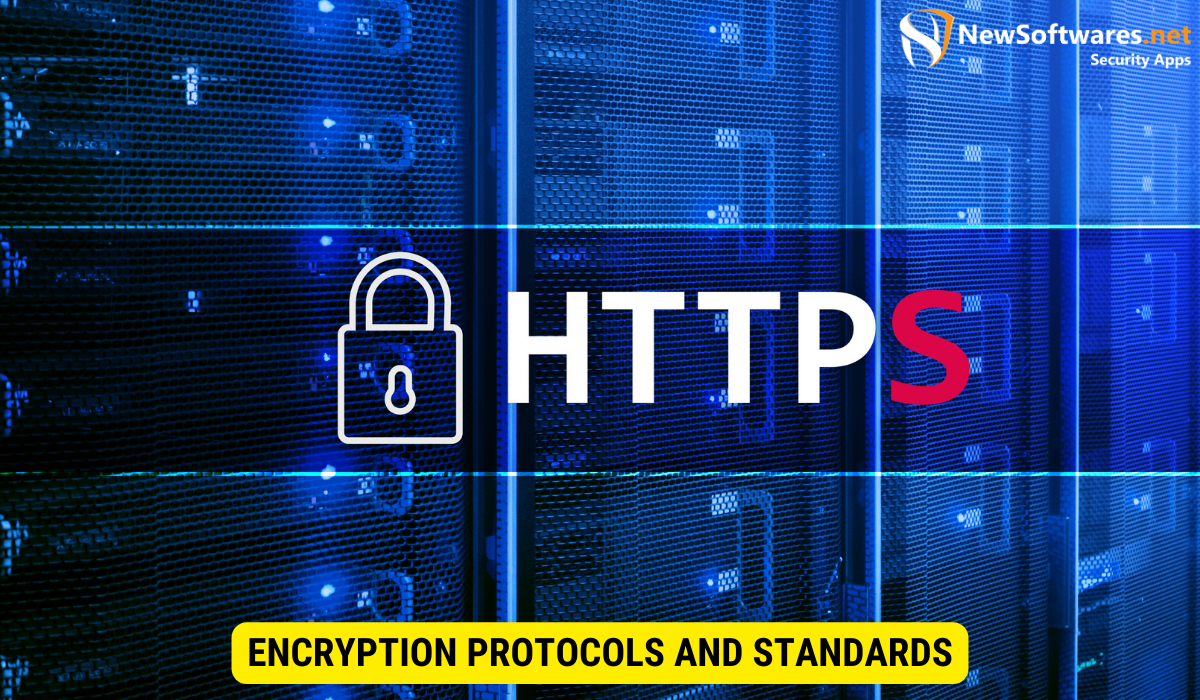Data in the cloud is encrypted using algorithms to convert it into unreadable ciphertext, accessible only with decryption keys.
The role of data encryption is critical in maintaining the safety and confidentiality of information housed in the cloud. In this detailed overview, we will delve into the multiple facets of data encryption within the cloud, including its significance, the fundamentals of cloud technology, the convergence of cloud services and data encryption, various cloud data encryption methods, and the protocols and standards for encryption. By the conclusion of this overview, you’ll possess a comprehensive understanding of the processes of data encryption in the cloud and the strategies available to safeguard your sensitive data.
Delving into Data Encryption

Data encryption is an intricate and vital process that ensures the security and privacy of data in the digital realm. It involves transforming readable text or data into an unreadable format, known as ciphertext, through an encryption algorithm. Only with a corresponding decryption key or password can this ciphertext be reverted to its original form.
Exploring Data Encryption
Taking a closer look at data encryption, when information is encrypted, it undergoes mathematical alterations that scramble the data, rendering it unreadable to anyone without the decryption key. This is akin to placing a confidential message in a locked container, which only the recipient has the key to open and interpret.
Various encryption methods are devised for maximum security, employing a range of cryptographic techniques including symmetric encryption, asymmetric encryption, and hashing. Symmetric encryption uses an identical key for both encrypting and decrypting data, while asymmetric encryption utilizes a public key for encryption and a private key for decryption. On the other hand, hashing transforms data into a unique, fixed-size string of characters, known as a hash value, representing the original data.
The Crucial Role of Data Encryption
In today’s ever-evolving digital threat landscape, the importance of encrypting data to protect it cannot be overstated. Here are the primary reasons why data encryption is indispensable:
- Securing Privacy: Encryption serves as a robust shield, keeping confidential data safe from unauthorized access. It turns data into a format that’s unreadable, ensuring that even if encrypted data is intercepted, understanding its true content without the unique decryption key is implausible.
- Mitigating Data Breach Impacts: In the event of a data breach, possessing encrypted data significantly hinders the decryption efforts of cybercriminals. This acts as a deterrent, reducing the impact of the breach on individuals and organizations. The longer it takes for attackers to decrypt the data, the more time organizations have to detect and respond to the breach.
- Compliance with Regulations: Many industries and regulatory bodies emphasize the importance of data encryption, requiring its use for certain types of data. For example, regulations like the General Data Protection Regulation (GDPR) or the Payment Card Industry Data Security Standard (PCI DSS) mandate the encryption of personal identifiable information (PII) and financial data to ensure adherence.
- Reinforcing Cloud Security: As the adoption of cloud technology grows, encrypting data becomes crucial for protecting information stored on external servers. Encrypting data before uploading it to the cloud ensures that, even in the case of a security breach at the cloud provider’s end, the data remains secure and indecipherable to unauthorized individuals.
As technological advancements continue, so too do the methods used by cyber adversaries to illicitly access confidential data. Encryption remains a key defensive strategy, preserving the privacy of information and safeguarding its confidentiality. Understanding the importance of data encryption and implementing stringent encryption strategies are vital for individuals and organizations looking to reinforce their security posture and avert their sensitive data from falling into the wrong hands.
Fundamentals of Cloud Computing
Defining Cloud Computing
Cloud computing involves the provision of computing services, such as storage, processing power, and applications, via the internet. Handlers can access and utilize these resources remotely, typically on a pay-per-use basis, rather than relying on local servers or personal devices.
Advantages of Cloud Computing
The benefits of cloud computing are manifold, including:
- Scalability: Cloud resources can be quickly adjusted to meet fluctuating demands, offering both flexibility and cost-effectiveness.
- Cost Efficiency: The shift away from on-premises infrastructure and maintenance to cloud computing can significantly reduce expenses.
- Accessibility: Users can access cloud resources from any location with an internet connection, facilitating both collaboration and remote work.
- Dependability: Cloud providers often implement redundant systems and backup measures, ensuring high service availability and data durability.
Cloud Computing and Data Encryption Intersect
The Need for Cloud Data Encryption
Encrypting data within the cloud is imperative for several reasons:
- Defense Against External Threats: Encrypting data prior to cloud storage ensures that, even if compromised, the data remains unintelligible to unauthorized parties.
- Meeting Compliance Mandates: Many industry regulations and data protection laws require the encryption of sensitive data.
- Shared Responsibility Model: While cloud providers are accountable for the security of the infrastructure, encrypting data adds an additional layer of defense against breaches.
Encryption Techniques Employed by Cloud Providers
Cloud providers typically apply encryption methods at various stages of data handling:
- In-Transit Data: Encryption safeguards data moving between the user’s devices and cloud servers from eavesdropping.
- At-Rest Data: Providers encrypt data stored on their servers, ensuring that even if the physical storage is compromised, the data remains secure and inaccessible.
- Key Management: Providers often offer services for the secure generation, storage, and rotation of encryption keys.
Varieties of Cloud Data Encryption
Symmetric Encryption
Symmetric, or secret key encryption, utilizes the same key for encryption and decryption, shared among the parties involved. This method is fast and efficient, suitable for encrypting large data volumes.
Asymmetric Encryption
Alternatively known as public-key encryption, this method employs a pair of mathematically linked keys: a public key for encryption and a private key for decryption. Asymmetric encryption offers enhanced security and enables secure exchanges between parties without prior key sharing.
Homomorphic Encryption
This advanced technique allows computations on encrypted data without necessitating decryption. This maintains data confidentiality while enabling processing, ideal for cloud computing scenarios.
Encryption Protocols and Standards

Advanced Encryption Standard (AES)
AES is a prevalent symmetric encryption algorithm, offering robust security and efficiency. It’s the standard choice for securing sensitive data across various applications, including cloud computing.
Secure Sockets Layer (SSL) and Transport Layer Security (TLS)
SSL and TLS are cryptographic protocols for securing network communications, including internet transactions. They ensure data transmitted between clients and servers remains encrypted and safe from tampering or interception.
Internet Protocol Security (IPSec)
IPSec is a suite of protocols for securing IP layer communications. It provides encryption, data integrity, and authentication services, making it suitable for securing data over VPNs and other network connections.
Key Insights
- Data encryption is crucial for protecting sensitive cloud-stored information.
- Cloud computing offers scalability, cost benefits, and remote resource access.
- Cloud data encryption adds a crucial protection layer and ensures regulatory compliance.
- Cloud providers implement encryption to secure data in transit, at rest, and provide key management services.
- Symmetric encryption, asymmetric encryption, and homomorphic encryption are prevalent cloud data encryption methods.
- AES, SSL/TLS, and IPSec are commonly utilized encryption protocols and standards.
Frequently Asked Questions
Is cloud data automatically encrypted?
No, cloud data isn’t inherently encrypted. Users and organizations must initiate encryption measures to secure their sensitive information.
Can encrypted data be hacked?
While encryption significantly enhances security, it’s not impervious to hacking. Weak algorithms, key compromises, or implementation errors can potentially expose encrypted data. However, robust algorithms and secure key management practices drastically lower hacking risks.
Is it possible to decrypt encrypted data?
Encrypted data can be decrypted with the correct key or password. Without the proper key, decryption becomes exceedingly challenging, rendering encryption an effective protection method.
Does encryption affect performance?
Encryption can impact performance, particularly with large data volumes. Nonetheless, modern hardware and software advancements have reduced the performance overhead, making encryption practical and efficient for most applications.
How do I secure my encryption keys?
To secure encryption keys, consider implementing strong access controls, utilizing key management systems for secure storage, regularly rotating keys, and enforcing strict auditing and monitoring.
Conclusion
In summary, encrypting data in the cloud is essential for safeguarding sensitive information and ensuring confidentiality. A thorough understanding of data encryption basics, the interaction between cloud computing and encryption, the different encryption types for cloud data, and the relevant encryption protocols and standards lays the foundation for implementing strong security measures in your cloud environment. By employing encryption and keeping abreast of best practices, you can protect your data and mitigate risks associated with storing information in the cloud.
